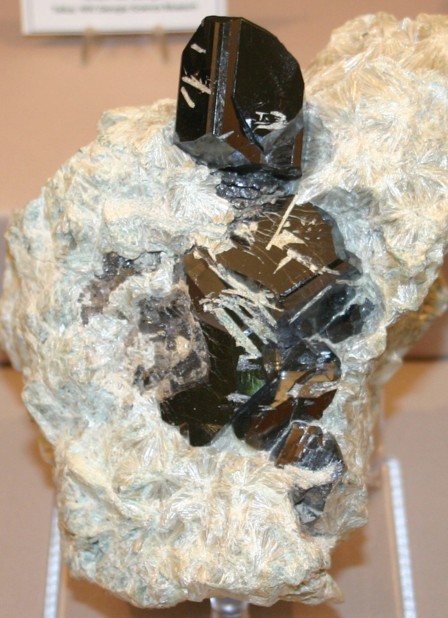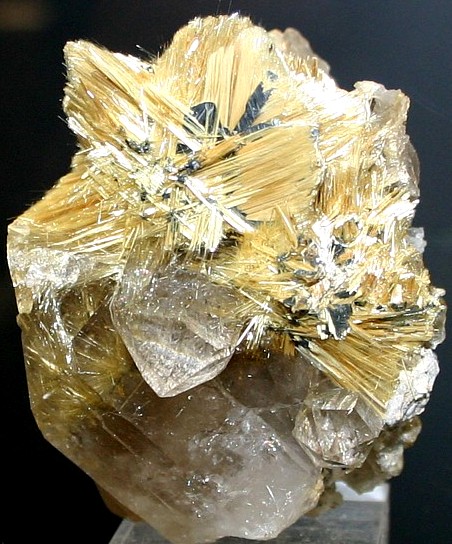|
.
Rutile Mineral Facts:
Chemical
Formula: TiO2
Nearly all specimens, however, contain in addition some iron,
occasionally as much as 9 per cent or 10 per cent.
Colors:
Reddish Brown to black.
The mineral is reddish brown, yellowish brown, black or bluish brown by
reflected light and sometimes deep red by transmitted light.
Hardness:
6.0 to 6.5
Density: 4.2
Cleavage:
Poor parallel
to the prisms (110) and (100).
Crystallography: Tetragonal
Usually prismatic with pyramid terminations. Usually crystallized
with Vertical striations. Twins are common, frequently in elbow
twins, often repeated.
Luster:.
Luster adamantine
to submetallic. Usually nearly opaque, but may be transparent.
Optics:
(Refractive Index): w= 2.612; e= 2.899
|
 |
|
Composition,
Structure and Associated Minerals:
Rutile is
one of the oxides of the comparatively abundant element titanium. It occurs
commonly in dark brown opaque cleavable masses and in brilliant black
crystals.
Rutile is often found as crystals embedded in limestone and in the quartz or
feldspar of granite and other igneous rocks, as long acicular crystals in
slates, and as grains in the rock known as nelsonite. It occurs also as fine
hair-like needles penetrating quartz, forming the ornamental stone "fleches
d'amour," and as grains in the gold-bearing sand regions.
When primary it is probably
always a product of magmatic processes, either crystallizing from a molten
magma
or being the result of
hydrothermal action. Pseudomorphs
of rutile after
hematite and after brookite and anatase have been described. It often
changes into ilmenite and
sphene.
Identification and Diagnostics
Some of the
dark red and reddish brown massive varieties of rutile may be confounded
with some varieties of garnet, which, however, are much harder. Its density,
its infusibility and the reaction for titanium serve to characterize the
mineral perfectly. Rutile is infusible and insoluble. Its reactions with
beads of borax and microcosmic salt are usually obscured-by the iron
present.
Occurrence,
Localities and Origins:
Rutile
is found in granite, gneiss, mica schist, metamorphic limestone and
dolomite, sometimes as an accessory mineral in the rock, sometimes in
quartz veins traversing it. Often occurs as slender crystals penetrating
quartz. Remarkable crystals come from Graves Mountain, Lincoln County,
Georgia. Also found in Alexander County, North Carolina, in Randolph County,
Alabama, and at Magnet Cove, Arkansas. Has been mined near Roseland, Nelson
County, Virginia.
In the latter place it occurs in large quantity as crystals disseminated
through a coarse granite rock. The rock containing about 10 per cent of
rutile is mined as an ore.
Notable European
localities are Kragero, Norway; Yrieux, near Limoges, France; in the Ural
Mountains.
Handsome crystals of the
mineral occur at Arendal, in Norway; in Tyrol, and at St. Gothard and in the
Binnenthal, Switzerland.
Rutile is an important ore of
titanium.
Man made rutile is used to impart a white color to paint. It is also used in
the manufacture of important ferro-titanium alloys which increase the
strength of steel.
Return to the
Mineral Collectors Information Page |

Slender Golden Crystals of Rutile
in and on Quartz |
|



